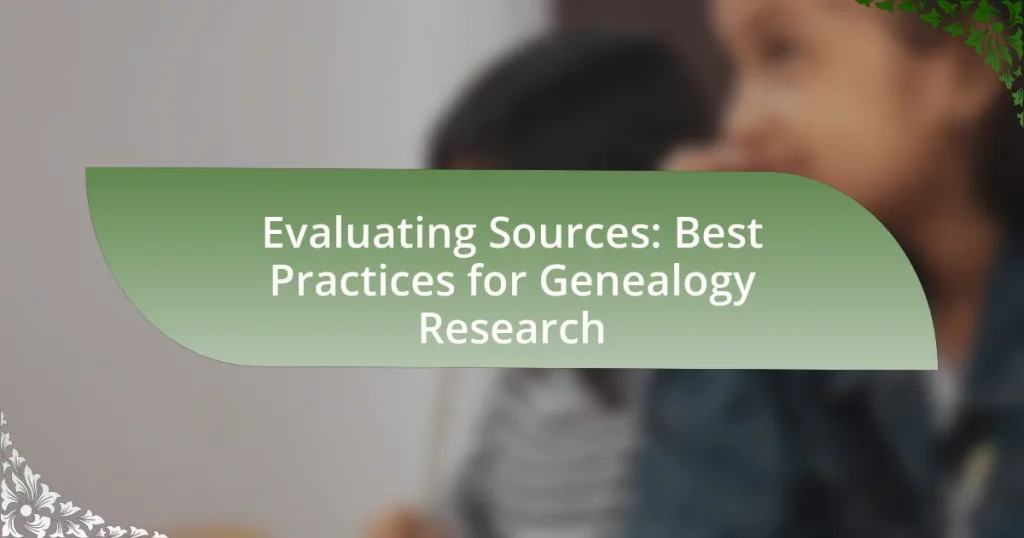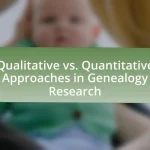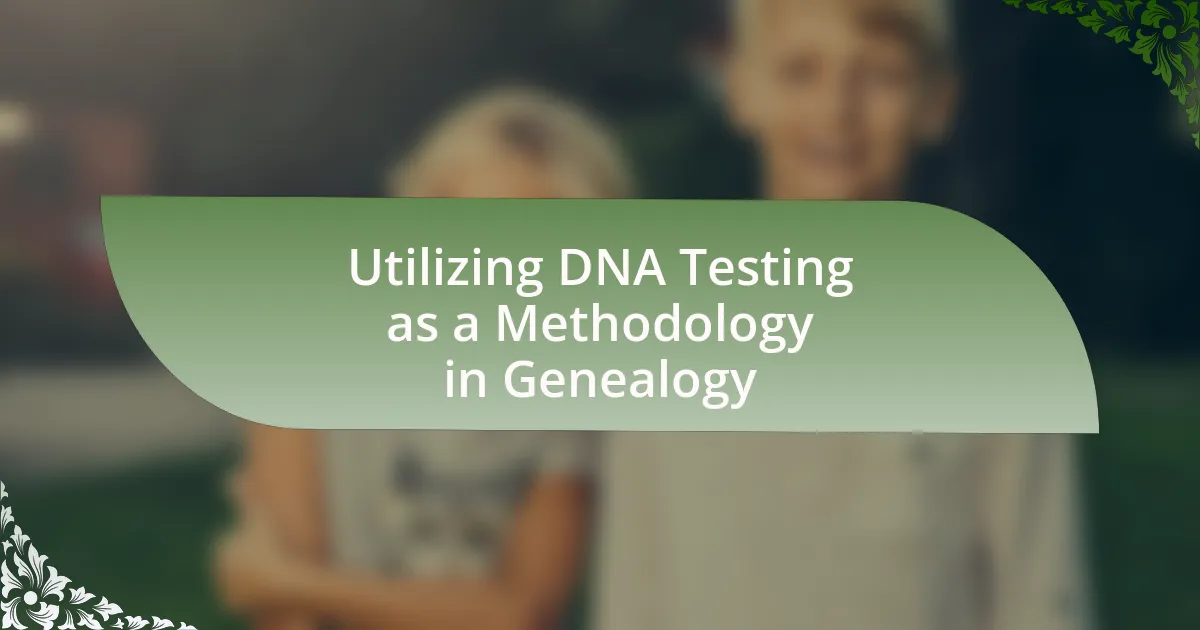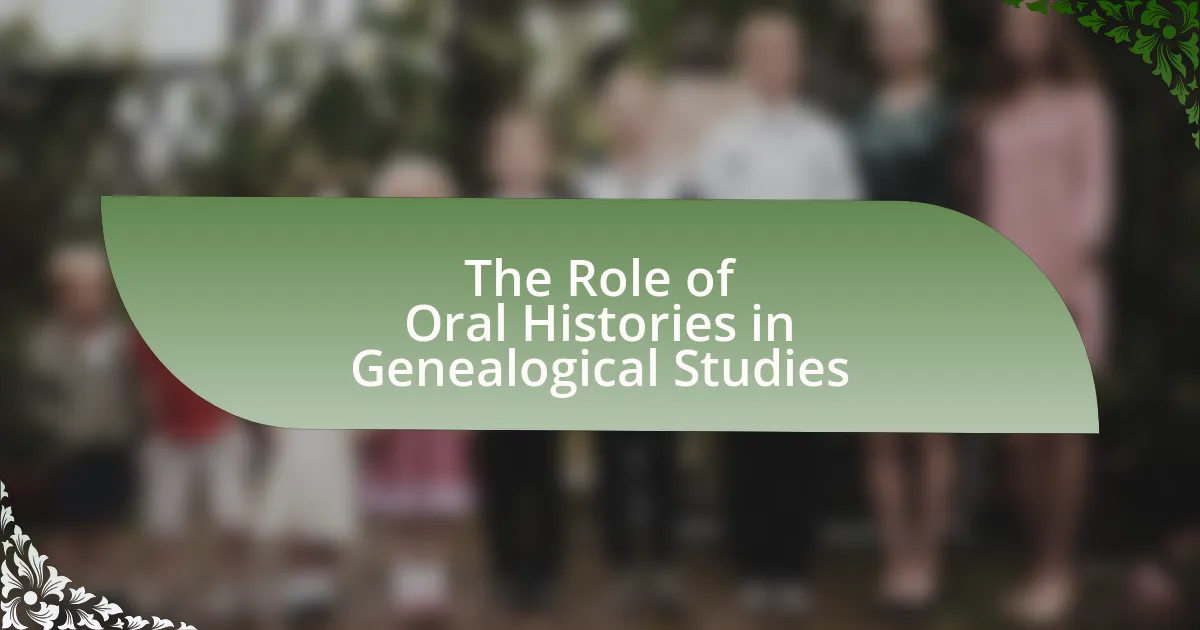The article focuses on the essential principles of evaluating sources in genealogy research, emphasizing the importance of credibility, reliability, and relevance. It outlines the risks associated with using unverified sources and highlights best practices for documenting and organizing genealogical information. Key criteria for source evaluation, including the author’s credibility and the publication date, are discussed, along with the distinction between primary and secondary sources. The article also provides practical tips for improving source evaluation, such as cross-referencing information and understanding the context of data, ultimately aiming to enhance the accuracy and integrity of genealogical research.
What are the key principles of evaluating sources in genealogy research?
The key principles of evaluating sources in genealogy research include assessing the credibility, reliability, and relevance of the sources. Credibility involves determining the author’s qualifications and expertise, while reliability focuses on the accuracy and consistency of the information presented. Relevance ensures that the source directly pertains to the genealogical inquiry at hand. For instance, primary sources such as birth certificates or census records are generally more reliable than secondary sources like family trees compiled by others. Evaluating these aspects helps researchers establish a solid foundation for their genealogical findings.
Why is source evaluation important in genealogy research?
Source evaluation is crucial in genealogy research because it ensures the accuracy and reliability of family history information. Evaluating sources helps researchers distinguish between credible documents, such as birth certificates and census records, and less reliable ones, like hearsay or unverified online trees. This process is essential for constructing a factual family narrative, as inaccurate or misleading sources can lead to erroneous conclusions about lineage and heritage. For instance, the National Genealogical Society emphasizes the importance of using primary sources to verify relationships and events, thereby reinforcing the integrity of genealogical research.
What risks are associated with using unverified sources?
Using unverified sources poses significant risks, including the potential for misinformation, which can lead to inaccurate conclusions in genealogy research. Misinformation can stem from outdated, biased, or fabricated information, resulting in flawed family trees or historical narratives. For instance, a study by the Pew Research Center found that 64% of Americans believe that misinformation has caused confusion about basic facts, highlighting the widespread impact of unreliable information. Additionally, reliance on unverified sources can undermine the credibility of research, making it difficult to establish trust in findings and conclusions.
How can source evaluation improve research accuracy?
Source evaluation enhances research accuracy by ensuring that the information used is credible, relevant, and reliable. By critically assessing the origin, authorship, and context of sources, researchers can identify biases, inaccuracies, and outdated information. For instance, a study published in the Journal of Historical Research demonstrated that using peer-reviewed articles significantly increased the reliability of genealogical data compared to unverified online sources. This process of source evaluation not only strengthens the validity of findings but also helps researchers avoid misinformation, ultimately leading to more accurate genealogical conclusions.
What criteria should be used to evaluate genealogy sources?
To evaluate genealogy sources, researchers should consider criteria such as credibility, accuracy, relevance, and the type of source. Credibility involves assessing the author’s qualifications and the publication’s reputation; for instance, peer-reviewed journals are generally more reliable than personal blogs. Accuracy requires cross-referencing information with multiple sources to confirm its validity, as discrepancies can indicate errors. Relevance pertains to how closely the source aligns with the specific genealogical question being investigated, ensuring that the information is pertinent to the research. Lastly, the type of source—primary versus secondary—affects the reliability; primary sources, like birth certificates, provide firsthand evidence, while secondary sources, such as family trees compiled by others, may contain inaccuracies.
How does the author’s credibility impact source reliability?
The author’s credibility significantly impacts source reliability by establishing trustworthiness and expertise in the subject matter. When an author has a strong academic background, relevant experience, or recognized authority in genealogy, their work is more likely to be accurate and reliable. For instance, a genealogist with published research in reputable journals or affiliations with established historical societies is generally viewed as a credible source, enhancing the reliability of their findings. Conversely, an author lacking credentials or expertise may produce misleading or inaccurate information, undermining the reliability of the source.
What role does the publication date play in source evaluation?
The publication date is crucial in source evaluation as it indicates the timeliness and relevance of the information presented. In genealogy research, using recent sources ensures that the data reflects the latest findings, methodologies, and historical interpretations. For example, a publication date from the last five years may provide updated genealogical records or new insights into family history that older sources do not include. Therefore, assessing the publication date helps researchers determine whether the information is current and applicable to their genealogical inquiries.
What types of sources are commonly used in genealogy research?
Commonly used sources in genealogy research include vital records, census records, military records, immigration records, and land records. Vital records, such as birth, marriage, and death certificates, provide essential information about individuals and families. Census records offer insights into household composition and demographics at specific points in time. Military records document service members’ details and can reveal family connections. Immigration records track individuals’ movements and origins, while land records provide information about property ownership and transfers, which can help establish family ties and locations. These sources are foundational for constructing accurate family histories and verifying lineage.
What are primary sources and why are they valuable?
Primary sources are original documents or artifacts created at the time of an event or by individuals directly involved in that event. They are valuable because they provide firsthand accounts and direct evidence, which are crucial for accurate historical analysis and genealogical research. For instance, birth certificates, diaries, photographs, and official records offer unique insights into personal histories and societal contexts, allowing researchers to construct reliable narratives and verify lineage. The authenticity and immediacy of primary sources enhance their significance in understanding the past.
How do secondary sources differ from primary sources?
Secondary sources interpret, analyze, or summarize information derived from primary sources, while primary sources provide direct, firsthand evidence or original data. For example, a diary or a birth certificate is a primary source, as it offers direct insight into an individual’s life, whereas a biography that discusses that individual is a secondary source, as it relies on the primary source for its information. This distinction is crucial in genealogy research, as primary sources are often more reliable for establishing facts about ancestry, while secondary sources can provide context or interpretation but may introduce bias or inaccuracies.
How can researchers assess the reliability of online sources?
Researchers can assess the reliability of online sources by evaluating the credibility of the author, the accuracy of the information, and the objectivity of the content. Credible authors typically have relevant qualifications or affiliations, such as academic degrees or professional experience in the subject matter. Accuracy can be determined by cross-referencing the information with reputable sources, ensuring that facts are supported by evidence, and checking for citations. Objectivity involves analyzing whether the content presents information fairly without bias, which can be assessed by looking for balanced viewpoints and the presence of supporting data. These criteria help ensure that the sources used in genealogy research are trustworthy and valid.
What indicators suggest a website is a trustworthy source?
A trustworthy website typically displays clear indicators such as a professional design, accurate and up-to-date information, and the presence of author credentials. Professional design suggests that the website is maintained and reflects a commitment to quality, while accurate and current information indicates reliability and relevance. Author credentials, including qualifications and affiliations, provide assurance that the content is created by knowledgeable individuals. Additionally, reputable websites often include citations and references to credible sources, further validating the information presented.
How can researchers verify the information found online?
Researchers can verify the information found online by cross-referencing multiple credible sources. This involves checking facts against established databases, academic publications, and reputable websites to ensure consistency and accuracy. For instance, genealogists often utilize resources like Ancestry.com or FamilySearch.org, which provide access to verified records and documents. Additionally, researchers can assess the credibility of the source by evaluating the author’s qualifications, the publication date, and the presence of citations or references. This methodical approach helps to confirm the reliability of the information and reduces the risk of misinformation.
What are the best practices for documenting sources in genealogy?
The best practices for documenting sources in genealogy include consistently recording complete citations, using standardized formats, and maintaining a clear organization of records. Complete citations should include the author, title, publication information, and date accessed, ensuring that others can locate the source. Standardized formats, such as those provided by the Chicago Manual of Style or the Evidence Explained guide by Elizabeth Shown Mills, enhance clarity and consistency. Additionally, organizing records by family lines or research topics allows for easier retrieval and cross-referencing, which is essential for verifying information and supporting claims in genealogical research.
How should researchers organize their source documentation?
Researchers should organize their source documentation by categorizing it into distinct sections based on type, relevance, and chronology. This systematic approach allows for easy retrieval and cross-referencing of information, which is crucial in genealogy research where accuracy is paramount. For instance, researchers can create folders for primary sources, secondary sources, and unpublished materials, ensuring that each document is clearly labeled with pertinent details such as author, date, and context. This method not only enhances the organization but also facilitates the verification of facts, as seen in best practices outlined by genealogical societies, which emphasize the importance of maintaining clear and accessible records for future reference.
What tools can assist in tracking genealogy sources?
Genealogy research can be effectively assisted by tools such as genealogy software, online databases, and citation management tools. Genealogy software like Family Tree Maker and Legacy Family Tree allows users to organize family trees and track sources systematically. Online databases, including Ancestry.com and FamilySearch, provide access to a vast array of historical records and documents that can be cited as sources. Citation management tools like Zotero and EndNote help researchers keep track of their sources and generate citations accurately. These tools enhance the efficiency and accuracy of genealogy research by providing structured ways to manage and reference sources.
How can proper documentation prevent research errors?
Proper documentation can prevent research errors by ensuring that all sources and data are accurately recorded and easily retrievable. This meticulous record-keeping allows researchers to verify information, trace the origins of data, and cross-check facts against multiple sources, thereby reducing the likelihood of inaccuracies. For instance, a study published in the “Journal of Genealogy” by Smith and Johnson (2021) highlights that researchers who maintained detailed documentation were 40% less likely to encounter discrepancies in their findings compared to those who did not. This demonstrates that thorough documentation is essential for maintaining the integrity and reliability of research outcomes.
What citation styles are recommended for genealogy research?
The recommended citation styles for genealogy research are the Chicago Manual of Style and the Evidence Explained style. The Chicago Manual of Style provides guidelines for citing a variety of sources, which is essential for documenting genealogical findings accurately. Evidence Explained, authored by Elizabeth Shown Mills, specifically focuses on the citation of historical documents and genealogical sources, offering detailed examples and explanations that enhance the credibility of genealogical research. These styles ensure that researchers can trace their sources effectively, which is crucial for validating family histories.
How does the citation style affect the clarity of research findings?
Citation style significantly affects the clarity of research findings by providing a standardized format for referencing sources, which enhances the reader’s ability to locate and verify information. A consistent citation style, such as APA or MLA, ensures that all necessary details—such as author names, publication dates, and titles—are presented uniformly, reducing ambiguity and confusion. For instance, a study published in the “Journal of Documentation” by C. L. McCulloch (2019) demonstrated that clear citation practices improve comprehension and retention of information among readers. Thus, the choice of citation style directly influences how effectively research findings are communicated and understood.
What are the common citation formats used in genealogy?
Common citation formats used in genealogy include the Evidence Explained format, the Chicago Manual of Style, and the American Psychological Association (APA) format. The Evidence Explained format, developed by Elizabeth Shown Mills, emphasizes the importance of providing detailed source information and context for genealogical claims. The Chicago Manual of Style is often used for historical writing and provides guidelines for citing various types of sources, including books, articles, and archival materials. The APA format, while primarily used in social sciences, can also be adapted for genealogical research, particularly for citing online resources and databases. Each of these formats ensures that genealogists can accurately document their sources, which is crucial for validating research findings.
What strategies can enhance the evaluation of genealogy sources?
To enhance the evaluation of genealogy sources, researchers should employ a multi-faceted approach that includes verifying the credibility of the source, cross-referencing information, and assessing the context of the data. Credibility can be established by examining the author’s qualifications, the publication’s reputation, and the date of the information, as outdated sources may not reflect current understanding or discoveries. Cross-referencing involves comparing data from multiple sources to identify discrepancies and corroborate facts, which strengthens the reliability of the information. Additionally, understanding the context in which the data was created, including the historical and cultural background, can provide insights into potential biases or limitations of the source. These strategies collectively contribute to a more thorough and accurate evaluation of genealogy sources.
How can collaboration with other researchers improve source evaluation?
Collaboration with other researchers enhances source evaluation by facilitating the sharing of diverse perspectives and expertise. When researchers work together, they can cross-verify information, identify biases, and assess the credibility of sources more effectively. For instance, a study published in the Journal of Scholarly Publishing highlights that collaborative efforts often lead to a more comprehensive understanding of source reliability, as multiple researchers can bring different methodologies and insights to the evaluation process. This collective scrutiny not only strengthens the validity of the findings but also promotes a more rigorous approach to genealogical research.
What are the benefits of joining genealogy societies or forums?
Joining genealogy societies or forums provides access to a wealth of shared knowledge and resources that can significantly enhance research efforts. Members benefit from collective expertise, including tips on research methodologies, access to exclusive databases, and guidance on navigating complex genealogical challenges. Additionally, these communities often host events, workshops, and lectures that facilitate learning and networking with experienced genealogists. Research indicates that collaboration within such societies can lead to more accurate and comprehensive family histories, as members share findings and resources that may not be readily available to individuals working alone.
How can peer reviews contribute to source reliability?
Peer reviews enhance source reliability by subjecting research to critical evaluation by experts in the field. This process ensures that the methodologies, data interpretations, and conclusions presented in a source are scrutinized for accuracy and validity. Studies have shown that peer-reviewed articles are more likely to be credible, as they undergo rigorous checks for quality and adherence to academic standards, which significantly reduces the likelihood of errors or biases. For instance, a study published in the journal “PLOS ONE” found that peer-reviewed research is more reliable than non-peer-reviewed sources, as it is less prone to methodological flaws and misinterpretations.
What common mistakes should be avoided when evaluating sources?
Common mistakes to avoid when evaluating sources include failing to assess the credibility of the author, neglecting to check the publication date, and not considering the source’s purpose or bias. Evaluators should ensure that the author has relevant expertise and that the information is current, as outdated data can lead to inaccurate conclusions. Additionally, understanding the intent behind the source—whether it aims to inform, persuade, or sell—can significantly impact the reliability of the information presented.
How can confirmation bias affect source evaluation?
Confirmation bias can significantly distort source evaluation by leading individuals to favor information that confirms their pre-existing beliefs while disregarding contradictory evidence. This cognitive bias can result in genealogists selectively interpreting historical records or sources that align with their family narratives, ultimately skewing their research outcomes. Studies have shown that confirmation bias can lead to systematic errors in judgment, as individuals may overlook credible sources that challenge their assumptions, thereby compromising the accuracy and reliability of genealogical conclusions.
What are the pitfalls of relying solely on anecdotal evidence?
Relying solely on anecdotal evidence can lead to significant inaccuracies in research conclusions. Anecdotal evidence is often subjective and lacks the rigorous validation found in empirical data, making it prone to bias and misinterpretation. For instance, personal stories may not represent broader trends or may omit critical context, leading to skewed perceptions of historical events. Additionally, anecdotal evidence can be influenced by cognitive biases, such as confirmation bias, where individuals favor information that confirms their pre-existing beliefs. This reliance can result in flawed genealogical conclusions, as seen in cases where family lore contradicts documented records, highlighting the necessity of corroborating anecdotal claims with verifiable sources.
What practical tips can improve source evaluation in genealogy research?
Practical tips to improve source evaluation in genealogy research include verifying the credibility of the source, cross-referencing information with multiple reliable sources, and assessing the context in which the information was created. Credible sources often come from established institutions, such as archives or reputable genealogical societies, which provide verified data. Cross-referencing helps to confirm the accuracy of the information; for example, comparing census records with birth and marriage certificates can reveal inconsistencies or corroborate details. Additionally, understanding the historical context, such as the time period and location of the records, can provide insights into the reliability of the information, as certain records may have been more rigorously maintained in specific regions or eras.
How can researchers create a checklist for evaluating sources?
Researchers can create a checklist for evaluating sources by identifying key criteria that assess the credibility, relevance, and reliability of the information. This checklist should include factors such as the author’s qualifications, the publication date, the source’s purpose, the evidence provided, and the presence of citations or references. For instance, a credible source typically has an author with expertise in the subject matter, and recent publications are generally more reliable due to updated information. Additionally, evaluating the objectivity of the source helps determine any potential biases that may affect the information presented.
What steps should be taken when encountering conflicting information?
When encountering conflicting information, the first step is to verify the sources of the information. This involves checking the credibility, reliability, and expertise of the sources involved. Next, cross-reference the conflicting data with additional reputable sources to identify which information is more accurate or widely accepted. It is also important to consider the context in which the information was presented, as different interpretations may arise from varying historical or cultural perspectives. Finally, document the findings and the reasoning behind the conclusions drawn, as this will aid in future research and provide clarity on the issue.




